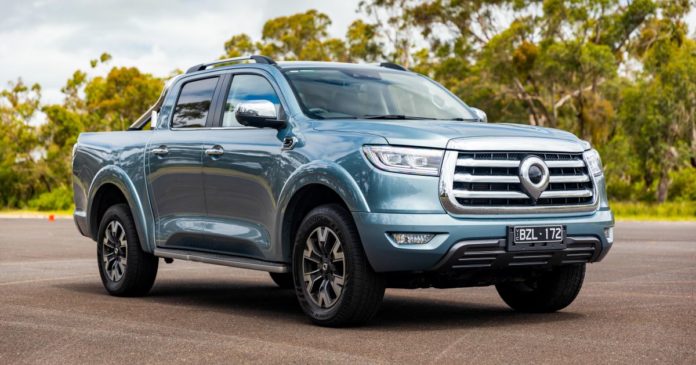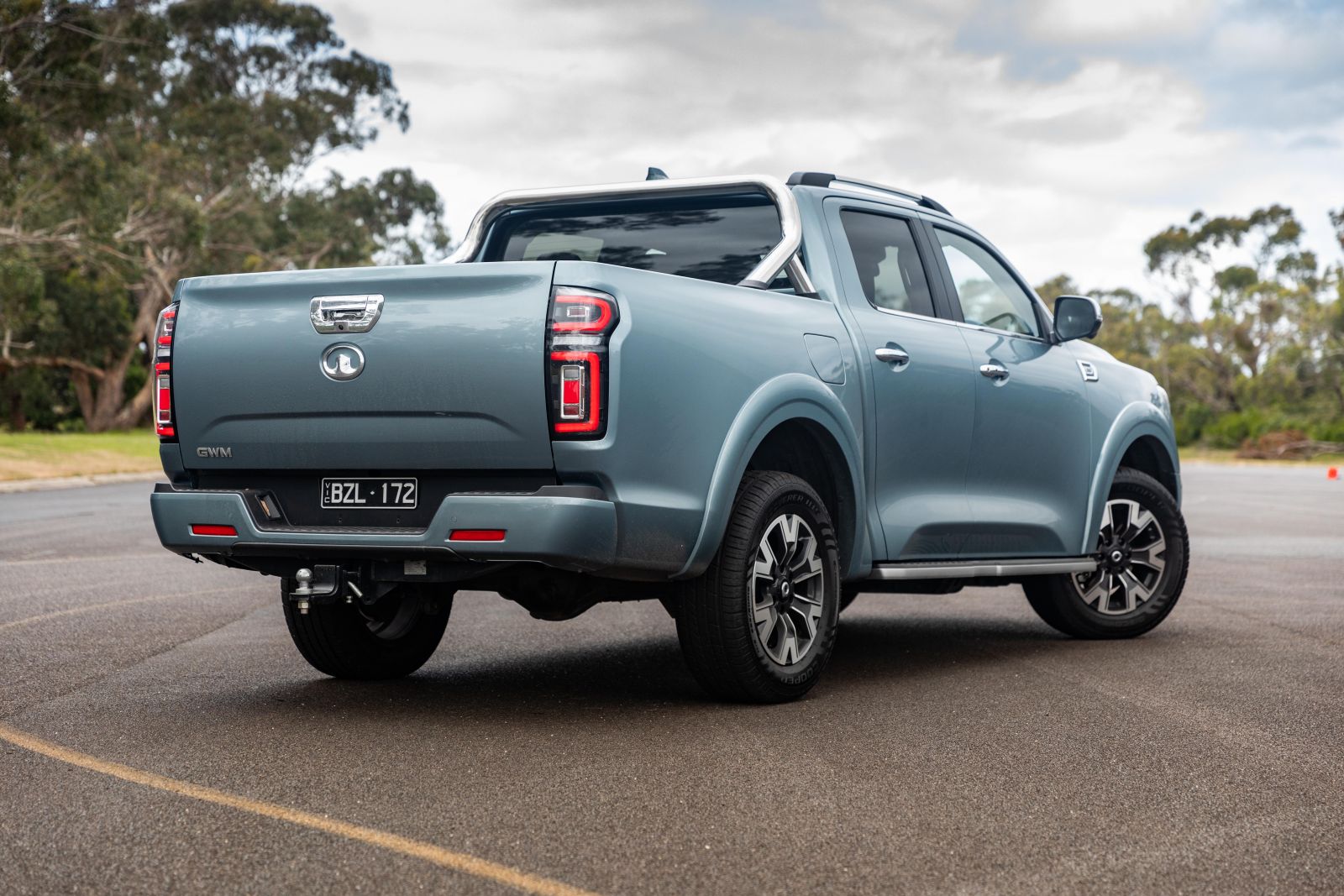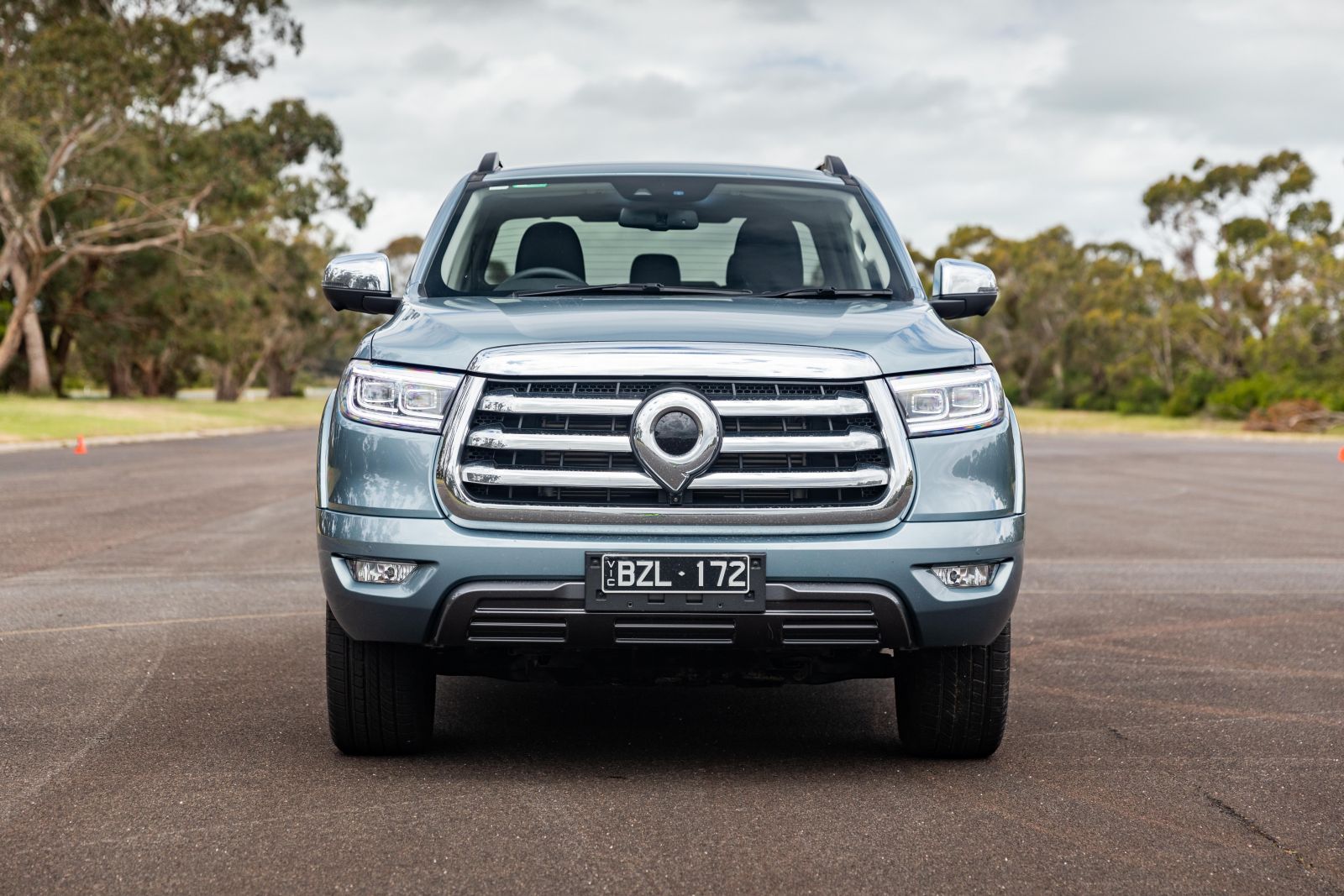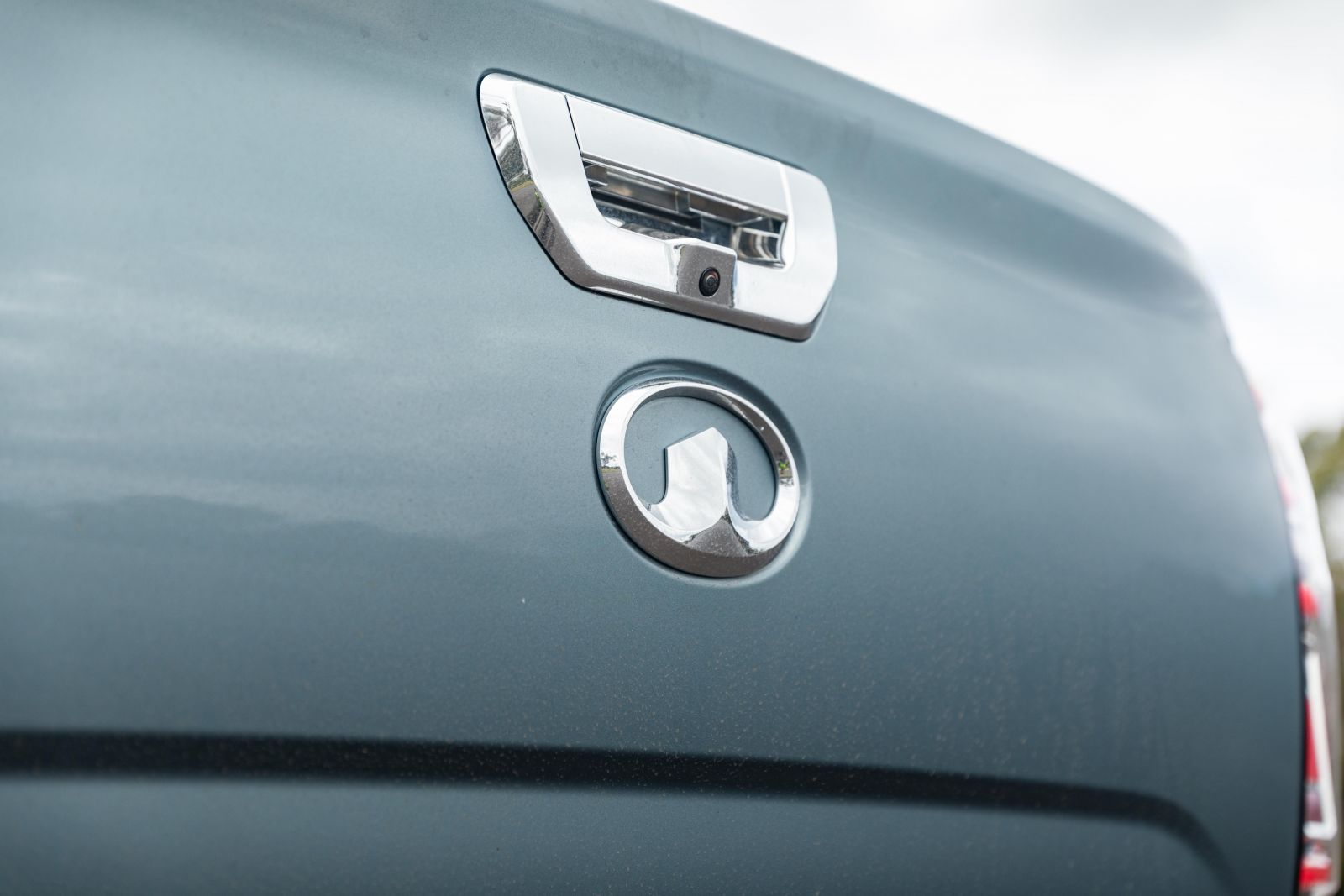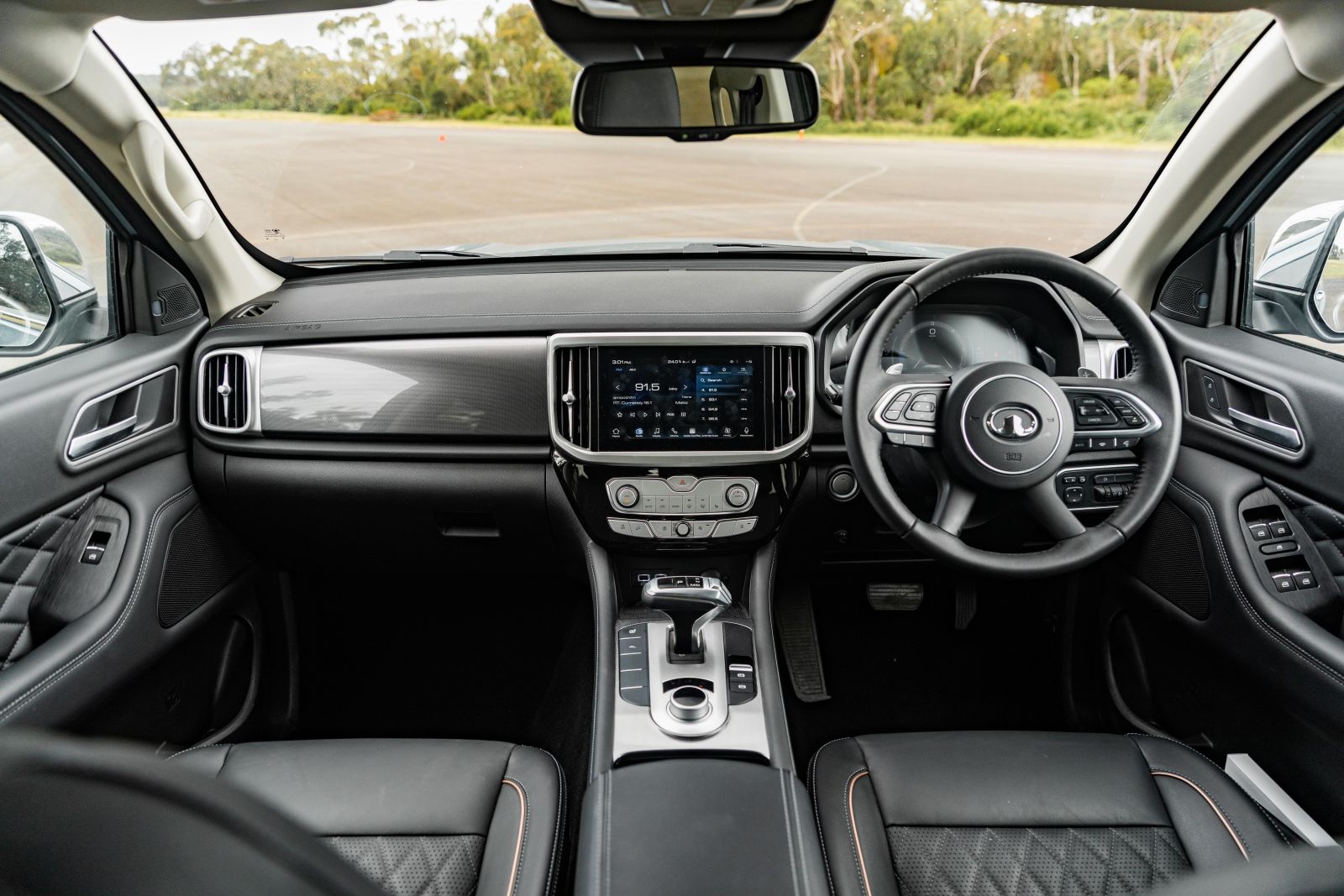The GWM Ute or GWM Cannon – whatever you want to call it – has ironically made quite a name for itself in Australia since launching here in early 2021.
The Chinese-made double-cab pick-up truck found almost 8000 buyers in Australia in 2022 alone, accounting for about 4.0 per cent of the ute market.
For a bit of context, that’s a smidge less than Nissan sold of its Navara, but more than VW sold of the runout Amarok, and well ahead of other cheap ute rivals, the LDV T60 and SsangYong Musso.
The range hasn’t seen a whole lot of change since it first appeared here. The base model is still just called the Cannon, and it has 4×2 and 4×4 models available; the mid-spec model is the Cannon-L, a 4×4-only proposition; and the one tested here is the Cannon-X 4×4. GWM also added a black pack version, called the Vanta, late in 2022.
The reason the GWM Ute is selling well is because it’s still astounding value for money, despite being more than 10 per cent dearer than when it first launched. So is it worth considering? And what’s it really like to live with as a family runaround?
I spent three weeks with this 20,000-kilometre old example to find out. The thing had seen some stuff in its life… you could damn near consider this a used (or abused) car review!
But it was pretty damn good for what I used it for – a big road trip with my crew to the country to see family for Christmas.
How much does the GWM Ute Cannon-X cost?
The price for this version of the Cannon ute is now $45,490 drive-away.
It must be stipulated, though, that this price is what is on offer in January 2023, and based on the last few years of price increases for GWM (and almost all other brands), it could rise again soon.
That price puts it pretty close to the range-topping SsangYong Musso Ultimate XLV ($43,090 drive-away), but it now needs you to tick a $3000 option box for the Luxury Pack inclusions to rival this ute… but it is available with a sunroof, and the GWM isn’t despite some of the animations of the ute on the media screen showing that it has one fitted. Oh and the SsangYong comes with a long-tray XLV version.
The other closely priced China-made ute is the LDV T60. The flagship diesel model of that range is $45,480 drive-away, or $49,463 drive-away for the Mega Tub model with a bigger cargo tray. It is nowhere near as well equipped or safety-conscious as the GWM, but it has a lot more power and torque than the Cannon, too.
The price may have gone up, but nothing has changed in terms of standard specifications for the GWM Cannon-X model. See more below.
2023 GWM Ute pricing:
- GWM Ute Cannon 4×2: $35,990
- GWM Ute Cannon 4×4: $38,990
- GWM Ute Cannon-L 4×4: $42,490
- GWM Ute Cannon-X 4×4: $45,490
- GWM Ute Cannon Vanta 4×4: $46,490
Prices are drive-away
It’s a shame GWM still doesn’t offer a standard soft or hard tonneau cover on any variant, but you can option them through the brand’s genuine accessories catalog, and I’d certainly be doing that if I was in the market for one. A canopy isn’t available as a genuine accessory, but there are options on the aftermarket.
Other accessories availble from GWM include a couple of different options for a bullbar, nudge bar, roller cover for the tray, floor mats, mud flaps and roof racks.
What is the GWM Ute Cannon-X like on the inside?
A bit peacocky, to be honest.
There’s some bluster about the cabin in this spec, because it has some luxury-look finishes that utes at this price point from the big-name brands can’t even dream of.
That quilted stitching on the ‘luxury leather’ seats is eye-catching, and so is the mimicked finish on the door cards. It really does look posh.
A shame, then, that feel doesn’t quite find itself applied to the dash, which is identical between the base and top grades. It isn’t ugly or anything, it just looks a bit more like the price you’re paying for the ute in terms of the materials and finishes.
But, that said, it comes as standard (as with all GWM utes) with a 9.0-inch touchscreen media system, which – thankfully – also includes buttons and dials below for the climate control. Some cheaper Chinese models require you to do everything through the screen, and that can be hard work on the road, not to mention if you’re a tradie with gloves on or filthy mitts.
However, while the buttons and dials make me happy, the fact that the screen above reverts to that on-screen displayed menu – even if you’re connected to Apple CarPlay or Android Auto – means you might miss a turn if you also want to adjust the temperature or fan speed. Heaven forbid if you want to turn the heated seats on or off, too (they’re in a different menu, again).
Then there’s the button down the bottom that looks like a ute with a circle around it. Get to know it, because if you’re like me, you’ll need to hit it every time you drive the ute.
That’s the safety assist systems menu button, so you’ll hit it, and then you’ll want to turn off the lane keeping assistance – because it’s one of the most assertive and overactive examples of the tech I’ve sampled. More in the driving section.
The storage on offer is okay up front, though it doesn’t have the much desired pop-out cup holders at the edges of the dashboard, like you get in the Isuzu D-Max and some versions of the Ford Ranger.
There is a pair of cupholders between the front seats, though they can be tricky to use when you’ve got large take-away cups in them. There’s a large console bin with an additional small item cubby sliding shelf there too, as well as bottle holders and storage slots in both front doors, and a decent glovebox.
In front of the gear selector there is a wireless phone charger, which is a nice touch, and a pair of USB ports nearby, too. Note, the T-bar style auto shifter is actually an e-shifter, so if you drive into a parking spot and turn the engine off, it’ll engage P for you, even if you’re in D or R. Otherwise there’s a P button on top.
Cannon intenders should also pay attention to the fact that the Cannon-X and Vanta models are the only versions that come with a tilt and reach adjustable steering wheel. The Cannon and Cannon-L grades have tilt only. Yuck.
Now, back-seat riders get a great deal in the GWM Ute, because it is one of the roomiest utes in this part of the market.
It has more back seat space than a HiLux, D-Max, Ranger, or any of the other trucks it competes with. I’m 182cm (6’0”), and I could easily slot in behind my own driving position with space in front of my knees, above my toes and above my head. It’s pretty broad, too, with a heap of space to fit three adults across if needed.
If you have kids (and want to go places with them) there are dual ISOFIX child-seat anchor points and two top-tether points (no centre top tether), and they are among the easiest in the ute market to hook up a top-tether strap to. Seriously – some of the other trucks out there should have a look at how GWM has done it.
There are directional air vents, and a USB port and 220-volt powerpoint, so those in the back row should be happy. Unless they want cup holders in the centre rear armrest, because there aren’t any. But there are dual map pockets and decent door pockets.
What’s under the bonnet?
It isn’t the biggest donk on the market, and that could matter to some buyers.
The GWM Ute runs a 2.0-litre four-cylinder turbo-diesel across all variants, and it has 120kW of power (3600rpm) and 400Nm of torque (1500-2500rpm).
There’s the choice of 4×2 (rear-wheel drive) or 4×4 (four-wheel drive) in the base model only, while the higher grades are 4×4 only. All grades come as standard with an eight-speed automatic transmission sourced from ZF, and paddle-shifters are standard too.
The towing capacity is not at the benchmark level, but that’s probably not a bad thing given the deficit this vehicle has on the grunt front. Unbraked towing capacity is 750kg, and braked towing capacity is rated to 3000kg.
For some context, the SsangYong has a 2.2L turbo-diesel with 133kW/400Nm and 3.5-tonne towing, and the LDV T60 Max has a 2.0L turbo-diesel with 160kW/500Nm, but 3.0-tonne braked towing.
How does the GWM Ute Cannon-X drive?
If you want the best driving ute in this segment, you’re going to need to double your budget for that Ford Ranger Raptor, because you’re not going to find it here.
That’s not to say that this thing is terrible to drive, but there is certainly room for improvement – almost across the board.
The engine is quite laggy down low in the rev range, so you will notice that it takes a beat before you actually start moving.
I don’t think it lacks pulling power once you’re up and running, though, and while I hardly tested it to its payload limits with my family of five (three humans, two dogs) and all our Christmas loot and luggage in the tray, it did what was asked of it, but never felt like it was going to threaten the laws of physics with its acceleration.
The eight-speed auto did a decent job too; though note I spent most of my time on the highway or on country back roads during my time with the GWM Ute, and I didn’t go off-road at all with it, nor did I tow anything. So these findings might not ring true for all scenarios.
The ride isn’t too horrid, but my partner did complain about it feeling bouncy on some pockmarked road surfaces in the NSW central west.
I didn’t tell her that this vehicle is designed for multiple different purposes – towing, loaded driving, off-roading and more; so of course there is some compromise to the comfort levels as the engineers need to decide what is the right balance of control and cushioning – I just agreed and we kept on our way.
That is to say, it is a ladder-chassis ute and it can have moments where it feels pretty unrefined in the way it deals with bumps, especially if you don’t have anything in the tub to push down over the back axle’s leaf-spring setup. But if you’re running around with a few hundred kilos in the tub all the time, it likely won’t be that big of an issue.
The steering is one of the more annoying elements of the drive experience. It can require quite a bit of arm work to park this big thing, and not only does the steering require plenty of turns lock-to-lock, the turning circle is pretty large too (13.1m). At least the action is light enough at low speeds to make it not too much of a chore.
The steering assistance system – or lane keeping technology – is really frustrating and quite frankly, it felt a bit more dangerous with it on rather than switched off. I found the way the system tugged the ute around on the road to be very disconcerting. So, suffice to say, I learned the sequence mentioned above to deactivate it every time I drove.
One other finding – the thing takes about 5.0 seconds to start up when it’s a cold-start. That can be annoying because you might think you’ve not hit the button hard enough!
What do you get?
The Cannon-X sits at the top of the range, but if you’re curious, the lower-grade versions are still pretty loaded with gear as standard. Here’s a rundown of the standard features for the entire range.
Ute Cannon highlights:
- 18-inch alloy wheels
- Body-coloured bumpers, wheel arches and mirrors
- LED headlights with auto shutoff
- Daytime running lights and fog lights
- Side steps
- Proximity key fob and button start
- Fake leather seat trim
- Manual air-conditioning
- 9.0-inch centre touchscreen
- Apple CarPlay, Android Auto
- 2 x front and 1 x rear USB points
Ute Cannon-L adds:
- Sports bar in the tub
- Chrome grille, door handles and mirrors
- Auto-folding side mirrors
- Roof racks
- Privacy glass
- Different ‘premium’ 18-inch alloys
- Spray-in tub liner
- Counterbalanced tailgate
- Cargo ladder
- Leather steering wheel wrap
- Heated front seats
- Powered driver’s seat adjustment
- Climate control with rear-seat air vents
- Front parking sensors
- 360-degree cameras
- Auto-dimming rear-view mirror
- 220V power socket
Ute Cannon-X (as tested) adds:
- ‘Luxury’ leather seats
- Tilt and slide adjustable steering
- 7.0-inch instrument cluster
- Wireless phone charging pad
- Power-adjustable passenger seat
- Power-assist steering modes
- Door open warning
- Second row 60/40 folding seat
- Voice recognition
Ute Cannon Vanta adds:
- Black 18-inch alloy wheels
- Black grille
- Black sports bar
- Black exterior mirror caps
- Black door handles
- Black badges
- No roof rails
Is the GWM Ute Cannon-X safe?
A few years ago, vehicles made in China were not known for stellar safety credentials, but these days vehicles like the GWM Ute are made for major markets and have to hit the standards set by crash test safety authorities to add to the consideration list for customers.
So it is that the GWM Ute has a five-star ANCAP safety rating from 2021, meaning it managed that feat against some of the strictest criteria to date.
It achieved 86 per cent for adult occupant protection, 87 per cent for child occupant protection, 67 per cent for vulnerable road user protection and 73 per cent for safety assist.
As such, it has the requisite safety technologies and equipment to meet the needs of families, business buyers and tradies alike.
Standard safety features include:
- 7 airbags incl. front-centre airbag
- AEB with Pedestrian, Cyclist detection
- Reversing, passenger kerbside camera views
- Rear parking sensors
- Lane departure warning
- Lane keep assist
- Blind-spot monitoring
- Rear cross-traffic alert
- Adaptive cruise control
- Speed warning
- Traffic sign recognition
- Tyre pressure monitoring
- Hill-start assist
- Hill-descent control
-
GWM Ute ANCAP
Ute Cannon-L adds:
Ute Cannon-X adds:
- Surround view camera with 3D view
- Front parking sensors
- Power assist steering modes
- Door open warning
How much does the GWM Ute Cannon-X cost to run?
If you intend to buy a GWM Ute, there are some ownership considerations to keep in mind.
The brand offers an impressive seven-year, unlimited-kilometre warranty for private buyers. For those intending to use their ute for a “commercial or business application, including but not limited to taxi, hire, rental, Uber, courier, security, driving school, tour, bus operator or emergency vehicle”, then the warranty is limited to seven years/150,000km.
The brand offers a capped price servicing program. But the service intervals are a bit odd. The first maintenance check is at six months/5000km, then servicing is due every 12 months/10,000km, and the capped-price plan only runs out to 54 months or 45,000km, whichever occurs first. Costs are $260, $360, $360, $360, $360 respectively.
Roadside assistance is included as well, for five years/unlimited kays.
The official combined cycle fuel consumption figure for the 4×4 versions is 9.4 litres per 100 kilometres. Choose the 4×2, and the number is 8.3L/100km.
I did more than a thousand kays in the GWM Ute Cannon-X I tested, and my indicated fuel consumption figure was 10.1L/100km, which I think is acceptable. But as mentioned, there was no towing, off-roading or heavy load driving during my test.
Fuel tank capacity is 78 litres (no long-range fuel tank is available), but that should mean you’ll get almost 800km from a fill.
CarExpert’s Take on the GWM Ute Cannon-X
It’s not perfect, but nor should it be for this kind of money.
The GWM Ute Cannon-X is a very impressive value-oriented dual-cab pick-up truck that is still the benchmark for budget trucks in our market.
It is, ahem, great for what you’re paying for it. So if you’re thinking that a five-year-old HiLux or Ranger with 200,000km seems a bit rich at $45,000 (they’re out there, seriously), then you should probably have a good look at the GWM Ute.
Also stay tuned for our upcoming Dual-Cab Ute Mega Test to see how the GWM Ute fares against key competitors in the segment.
Click the images for the full gallery
MORE: Everything GWM Ute

